
Pisa is a city and comune in Tuscany, central Italy, straddling the Arno just before it empties into the Ligurian Sea. It is the capital city of the Province of Pisa. Although Pisa is known worldwide for its leaning tower, the city contains more than twenty other historic churches, several medieval palaces, and bridges across the Arno. Much of the city's architecture was financed from its history as one of the Italian maritime republics.
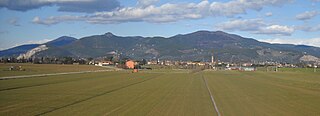
The province of Pisa is a province in the Tuscany region of Italy. Its capital is the city of Pisa. With an area of 2,448 square kilometres (945 sq mi) and a total population of 421,642, it is the second most populous and fifth largest province of Tuscany. It is subdivided into 37 comuni.
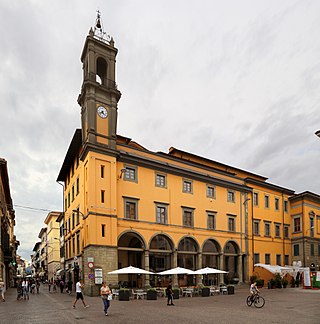
Pontedera is an Italian comune with a population of 29,270 inhabitants, located in the province of Pisa, Tuscany, central Italy.

The Serchio is the third longest river in the Italian region of Tuscany at 126 kilometres (78 mi), coming after the Arno at 242 kilometres (150 mi) and the Ombrone, 161 kilometres (100 mi). By mean rate of flow, it is the second largest, smaller than Arno but larger than Ombrone.

Bagni di Lucca is a comune of Tuscany, Italy, in the Province of Lucca with a population of about 6,100. The comune has 27 named frazioni (wards).

Borgo a Mozzano is a town and comune in the province of Lucca, in northern Tuscany (Italy), located on the Serchio River.
Fornaci di Barga, or simply Fornaci, is a frazione of Barga in the Province of Lucca, Tuscany, Italy. It is located 165 m above sea level, on the left bank of the river Serchio.

Pisa Centrale railway station is the central station of the Italian city of Pisa, the first station of the city in terms of passengers, before Pisa San Rossore railway station. The station is one of the major railway junctions of Tuscany. Lines serving the station include three long-distance lines: the Pisa–Livorno–Rome line, the Pisa–La Spezia–Genoa line and the Pisa–Florence line. Local services operate on the Lucca–Pisa line. The line from Pisa to Vada via Collesalvetti, which was closed from 1992 to 2000, is now only open for freight traffic.
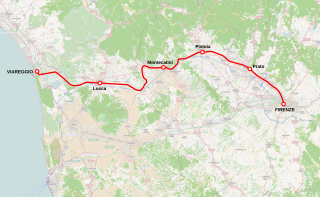
The Viareggio–Florence railway is a line built between 1848 and 1890 connecting the Tuscan cities of Florence, Prato, Pistoia, Lucca and Viareggio. The first section from Florence to Pistoia was named in honour of Princess Maria Antonia of the Two Sicilies, wife of Leopold II, Grand Duke of Tuscany, who had already been honoured in the naming of the Leopolda railway from Florence to Livorno. It is fully electrified at 3,000 V DC. Passenger traffic is managed by Trenitalia.

The Pisa–Lucca railway is a line that was built in 1846 connecting the Tuscan cities of Pisa and Lucca. It is fully electrified at 3,000 V DC. Passenger traffic is managed by Trenitalia.

Lucca railway station serves the city and comune of Lucca, in the region of Tuscany, central Italy. Opened in 1846, it forms part of the Viareggio–Florence railway, and is also the junction for lines to Pisa and to Aulla. All of these lines are only served by regional trains.

The Genoa–Pisa railway is one of the trunk lines of the Italian railway network. It runs along the Ligurian coast from Genoa to Pisa through the Riviera di Levante and the Versilia. It passes through the cities of Massa, Carrara and La Spezia. South of Pisa the Pisa–Rome line continues along the Tyrrhenian coast to Rome. The line is double track and is fully electrified at 3,000 V DC. Passenger traffic is managed by Trenitalia.

The Pistoia–Bologna railway is an Italian railway connecting Bologna to Pistoia and was the first line through the Apennines between Tuscany and Emilia-Romagna. It is also known in Italian as the Ferrovia Porrettana or the Transappenninica ("trans-Apennines"). It was officially called the Strada ferrata dell'Italia Centrale and was officially inaugurated by King Victor Emmanuel II in 1864.

Gello is a village in Tuscany, central Italy, administratively a frazione of the comune of San Giuliano Terme, province of Pisa. At the time of the 2001 census its population was 1,830.
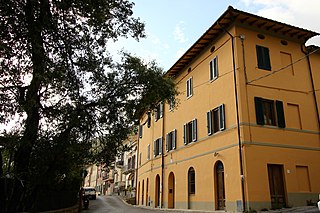
Agnano is a village in Tuscany, central Italy, administratively a frazione of the comune of San Giuliano Terme, province of Pisa. At the time of the 2001 census its population was 518.

Sant'Andrea in Pescaiola is a village in Tuscany, central Italy, administratively a frazione of the comune of San Giuliano Terme, province of Pisa. At the time of the 2001 census its population was 402.
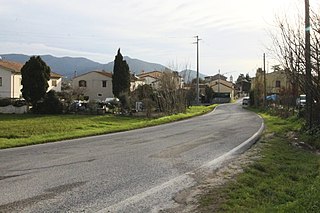
Campo is a village in Tuscany, central Italy, administratively a frazione of the comune of San Giuliano Terme, province of Pisa. At the time of the 2001 census its population was 1,064.

Colognole is a village in Tuscany, central Italy, administratively a frazione of the comune of San Giuliano Terme, province of Pisa. At the time of the 2001 census its population was 164.

Patrignone is a village in Tuscany, central Italy, administratively a frazione of the comune of San Giuliano Terme, province of Pisa. At the time of the 2001 census its population was 160.

The Lucca-Aulla railway also known as the Garfagnana railway is an Italian railway branch line. Running from the city of Lucca the line crosses the Garfagnana and Lunigiana regions to join the Parma–La Spezia railway in Aulla.




















